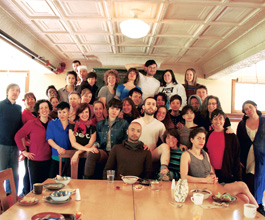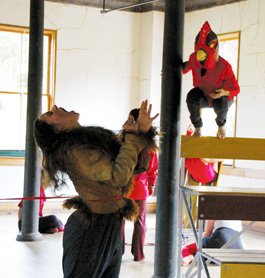home | north bay bohemian index | news | north bay | feature article

Photograph by Alma Shaw
HALL OF GAME: Interaction and public programs are key to the Headlands Center's mission.
Shared Growth
Artistic cross-pollination is in the (salty) air at the Headlands Center for the Arts
By Leilani Clark
Undeveloped rolls of film. People explaining how they got their scars. Videos of babies in strollers.
Some people might say that Harrell Fletcher's art is weird. Some people might even say that Harrell Fletcher's art isn't art at all. But at the Headlands Center for the Arts, a former Army barracks turned artistic haven situated on the Marin Headlands, Fletcher's unconventional and thought-provoking approach to the artistic process fits right in.
One of 900 artists who have lived at Headlands Center for the Arts (HCA) since its artist-in-residence program began in 1986, Portland-based Fletcher is among the notable names who have benefited from the HCA and its mission. Ten of those artists have gone on to receive MacArthur Fellowship grants. The songwriter Will Oldham, aka Bonnie "Prince" Billy, spent three months at the HCA in 2008, during which time he wrote the songs comprised on his 2009 album Beware.
According to Holly Blake, residency manager for over 20 years, the Headlands Center for the Arts began as all great dreams do—with a crowbar.
A military outpost for a hundred years, the buildings sat empty and fell into disrepair after the U.S. Army withdrew in 1972. Headlands' cofounder David Ireland decided to explore the site by taking a crowbar to the boarded-up doors of the four-story army barrack, and with a flashlight, beneath a leaking roof dripping rain, Ireland saw the "good bones" of the building, says Blake. Thus began the envisioning of a thriving art center where artists could come to engage with the creative process in a deeper manner while staying connected to the outside world.
The Headlands residency is multidisciplinary and includes dancers, photographers, writers and musicians, all of whom maintain that there's something special about the locale beyond the one-lane tunnel that connects Sausalito to the Headlands. "Go through that tunnel, and you're transported into a different world," says Sharon Maidenberg, executive director of the nearly 30-year-old program. "The place is beautiful and inspiring—not in a hokey way, but in a real and powerful way, because of the layers of history and of quite literally being on the edge of the world."
Harrell Fletcher first arrived at the Headlands for an open house in 1987. Blown away by the beauty of the environment and the "interesting cultural experiences," he made it his mission to return. In 1995, he was chosen for a graduate fellowship program, and in 1998 was selected as an artist in residence, an experience for which there are usually 1,500 applicants to fill one of 45 spots, which come free of cost, including travel, studio space, dinners and housing for anywhere from a few weeks to a few months.

Photograph by Alma Shaw
HOME TO ROOST: Participants prepare for a recent 'SQUART' performance at the Headlands Center.
Fletcher is now founder of the Art as Social Practice program at Portland State University (LearningToLoveYouMore.com, a participatory website created with filmmaker/writer/performance artist Miranda July, was acquired by the San Francisco Museum of Modern Art in 2010), and credits the Headlands for shaping his career.
"It always seemed like an amazing alternative to the urban art scene," he tells me as we talk over the sounds of clanking pans in the mess hall. "To come out here and feel really relaxed, in such a beautiful area, and the interaction with ocean, the raccoons, the birds."
HCA offers public programs and access to galleries, performances and lectures, though its focus is the artist-in-residence program. Since the program is process- rather than project-based, artists can follow their own path during the stay, encouraged to take walks along the rugged coast and interact with the environment. The only requirement is showing up for dinner in the mess hall each evening.
"We don't mandate that they do anything specific," says Maidenberg. "Most folks are coming in at moments in their career when some time away from their reality will be important to their creative process."
Brian Teare, a San Francisco-based poet known for his challenging and dense prose, will be an artist-in-residence this summer. "Because I write a lot about the coast and coastal ecology, I really liked the idea of being able to hike around in that area," says Teare. The multidisciplinary aspect of the program drew him in as well, he says. "I like being able to have dinner with visual artists and have a cross-genre conversation. In urban areas, the communities don't overlap that much."
Rather than a venue in which to sit in isolation, the HCA blurs the boundaries that tend to exist between artist and viewer. It's open to the public, with public-program days offered twice a month. San Francisco-based dancer and choreographer Laura Arrington currently inhabits the Project Space gallery, which allows artists to share their working processes with the public. Arrington will work for five days a week in the gallery under an open-door policy where anybody can drop in and observe her creative process.
Arrington says she was drawn to sharing her process with the public because her work already carries this as a strong element.
The buildings, with their continued renovation and historical energy, lie at the core of the HCA. The second-floor public rooms have been renovated to uncover cracks, layers of paint and building materials. Over dinner, I talk with Andre Dekker, a member of the art and architecture collective called "Observatorium." Dekker wears a rumpled jacket, says that he's jet-lagged from a flight from the Netherlands and is at HCA for the next three weeks to plan a renovation of the gym.
"This was cultivated for defense purposes, and now we can cultivate it further," Dekker says, touching on the HCA's role as an artistic outpost in a militarized society. Indeed, it's hard to imagine that the cozy, yellow-walled mess hall designed by Ann Hamilton during her own one-year residency in 1989 was once filled with soldiers grimly tucking into gruel before going out to play war games on the beach.
Maidenberg echoes that the HCA's history, combined with its casual approach to the artistic process and its open-door policy, is a humanizing experience. It's this element of the human, of the celebration of the everyday, that comes through in the public art projects of alumni like Harrell Fletcher, who takes things like baby strollers and wind chimes and makes them into something that deserve a second look.
"It wouldn't be interesting to have a bunch of artists holed up, making stuff in isolation," says Maidenberg. "Everything really is connected. We want people to have broader experiences that are truly impacting their practice, but also impacting their world and their lives as people."
Send a letter to the editor about this story.
|
|
|
|
|
|